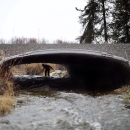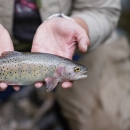States
Utah, WyomingThe Upper Bear River straddles the border between Wyoming and Utah and has been a long-term refuge for native Bear River Cutthroat, which are unique to the watershed. However, the area is also one of the oldest agricultural districts in Wyoming and Utah and impacts from water usage over the last half century have greatly impacted the ability of native fishes to migrate and utilize the full extent of the Bear River as a climatic refuge. This project is implementing four diversions to re-open 44.7 miles of important habitat as part of a decades long effort to improve aquatic connectivity. The Old Evanston Dam will have the river re-channeled around it, Sims Creek Slough Diversion will be replaced with a rocky ramp/vane installation, Hilliard Canal project needs funding to modify existing rocky vanes for fish passage fish passage
Fish passage is the ability of fish or other aquatic species to move freely throughout their life to find food, reproduce, and complete their natural migration cycles. Millions of barriers to fish passage across the country are fragmenting habitat and leading to species declines. The U.S. Fish and Wildlife Service's National Fish Passage Program is working to reconnect watersheds to benefit both wildlife and people.
Learn more about fish passage and install 2,000 feet of pipe, and the North Eden Creek project also replaces a diversion with a rocky ramp/vane. The Bear River is located in a rural portion of Wyoming. In addition to benefiting fish and aquatic wildlife, this project will pro-vide jobs and recreational opportunities that can stimulate the economy.
Quick Facts:
| Project Status | Active |
| Location | WY/UT, Uinta/Rich |
| NFPP Project Funding | $1,390,000 |
| Restoration Techniques | Dam Removal |
| Accomplishments | 10 Stream Miles Reopened |
| Project Partner Lead | Trout Unlimited |
| Primary Species Benefited | Bear River Cutthroat |
The National Fish Passage Program combines technical expertise with a track record of success.
Implemented primarily through the Service's Fish and Wildlife Conservation Offices, the National Fish Passage Program provides financial and technical assistance to partners across the country. Since 1999, the program has worked with over 2,000 local communities, Tribes, and private landowners to remove or bypass over 3,400 barriers to fish passage and reopen access to over 61,000 miles of upstream habitat for fish and other animals. Staff have expertise in fish migration and biology as well as financial, engineering, and planning assistance to communities, Tribes, and landowners to help them remove barriers and restore rivers for the benefit both fish and people.
Fish passage project proposals can be initiated by any individual, organization, government, or agency. However, proposals must be submitted and completed in cooperation with a Fish and Wildlife Conservation Office. (Please note that fish passage projects being used for federal or state compensatory mitigation or required by existing federal or state regulatory programs are not eligible for funding through the National Fish Passage Program.)
CONTACT A FISH PASSAGE COORDINATOR IN YOUR AREA TO GET STARTED.





